Themed collection Crystal Engineering Techniques

Organic co-crystal semiconductors: a crystal engineering perspective
Organic semiconductors are being pursued with vigor for the development of efficient and smart electronics. As a brief tutorial account, we traverse the fundamentals and advancements in the area and provide a crystal engineering perspective.
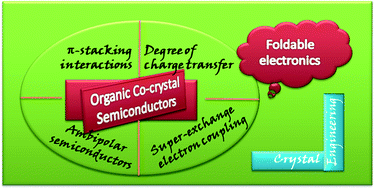
CrystEngComm, 2021,23, 8007-8026
https://doi.org/10.1039/D1CE01117K
Cocrystal engineering of pharmaceutical solids: therapeutic potential and challenges
This highlight presents an overview of pharmaceutical cocrystal production and its potential in reviving problematic properties of drugs in different dosage forms. The challenges and future outlook of its translational development are discussed.
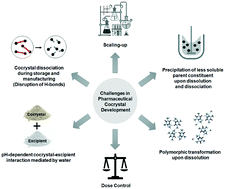
CrystEngComm, 2021,23, 7005-7038
https://doi.org/10.1039/D1CE00825K
Determining the mechanisms of deformation in flexible crystals using micro-focus X-ray diffraction
A newly developed methodology allows for the determination of the mechanisms of deformation in flexible crystals with atomic precision. With broader applications, mapping experiments have wide reaching potential within the field of materials science.
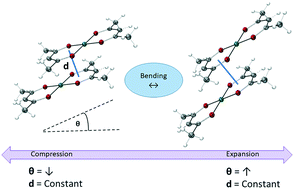
CrystEngComm, 2021,23, 5731-5737
https://doi.org/10.1039/D1CE00401H
Functional flexible molecular crystals: intrinsic and mechanoresponsive properties
Flexible molecular crystals have attracted much attention to unique optoelectronic applications and stimuli-responsive chemistry, resulting in various functional molecular crystals for controlling photons, phonons, electrons, and magnons.
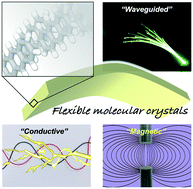
CrystEngComm, 2021,23, 5686-5696
https://doi.org/10.1039/D1CE00388G
Potential and challenges of engineering mechanically flexible molecular crystals
Crystal adaptronics has undergone tremendous developments that have been utilized to rationalize dynamics in crystals. This highlight discusses about the role of intermolecular interactions in rationalizing mechanical responses in crystals.
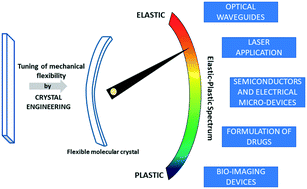
CrystEngComm, 2021,23, 5711-5730
https://doi.org/10.1039/D1CE00173F
Variable stoichiometry cocrystals: occurrence and significance
Stoichiometric variation in organic cocrystals, their synthesis, structure elucidation and properties are discussed. Accountable reasons for the occurrence of such cocrystals are emphasised.
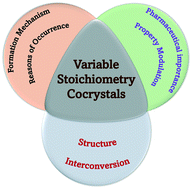
CrystEngComm, 2021,23, 4583-4606
https://doi.org/10.1039/D1CE00451D
Latency control of chemical reactions in polymerization of epoxy resins using a hydrogen bonding network
Latency control on the basis of molecular design of a solid state by introducing hydrogen bonding into epoxy curing agents.
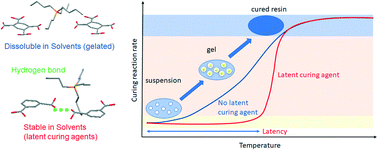
CrystEngComm, 2021,23, 7717-7719
https://doi.org/10.1039/D1CE01163D
Selectivity of hosts for guests by liquid-assisted grinding: differences between solution and mechanochemistry
Selectivity profiles obtained mechanochemically differ from those obtained in solution, both for selectivity during crystallisation and selectivity by guest exchange.
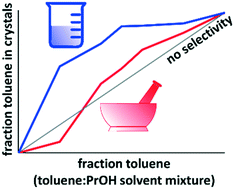
CrystEngComm, 2021,23, 7380-7384
https://doi.org/10.1039/D1CE01286J
Rank and signature classification of topochemical solid-state reactions
Solid-state reactions are classified into 10 categories based on the unit cells of the reactant and product.
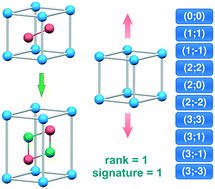
CrystEngComm, 2021,23, 7198-7201
https://doi.org/10.1039/D1CE00943E
Separation of a diastereomeric diol pair using the mechanical properties of crystals
The visually indistinguishable acicular crystals of a (2S,3R/S)-3-ethyl-1-phenylhex-5-ene-2,3-diol (ephd) diastereomeric pair are separated via the mechanical response based on elastic (2S,3R, right) and brittle (2S,3S, left) crystals.

CrystEngComm, 2021,23, 7056-7060
https://doi.org/10.1039/D1CE01055G
Isonicotinic acid-templated metal phosphate–oxalates: solvent-free synthesis, luminescence, and proton conduction
Two new layered metal phosphate–oxalates were prepared under solvent-free conditions using isonicotinic acid as a structure-directing agent, which show interesting photoluminescence and proton-conducting properties.

CrystEngComm, 2021,23, 6855-6858
https://doi.org/10.1039/D1CE00873K
Influence of crystallisation on the structural and optical properties of lead-free Cs2AgBiBr6 perovskite crystals
We compare the growth of Cs2AgBiBr6 crystals by slow and fast evaporation of organic solvents. Using different growth temperatures and precursors enables bridging the gap between the optical properties and applications of Cs2AgBiBr6 in solar cells.
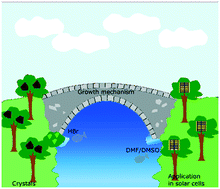
CrystEngComm, 2021,23, 6848-6854
https://doi.org/10.1039/D1CE00844G
Multicomponent crystals of an artemisinin derivative and cinchona alkaloids for use as antimalarial drugs
Multicomponent crystals of an artemisinin derivative and cinchona alkaloids were produced, combining two major types of antimalaria drugs with unique hydrogen bond interactions. These salts demonstrate a new category of antimalarial pharmaceuticals.
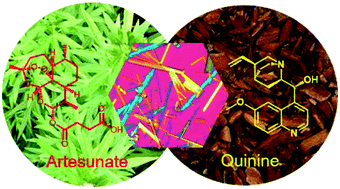
CrystEngComm, 2021,23, 6843-6847
https://doi.org/10.1039/D1CE00974E
Mechanophotonic aspects of a room temperature phosphorescent flexible organic microcrystal
A novel crystal of PTX-2CF3 exhibits room temperature phosphorescence and mechanical flexibility. This flexible crystal efficiently transduces optical emission both in the straight and bent geometries.
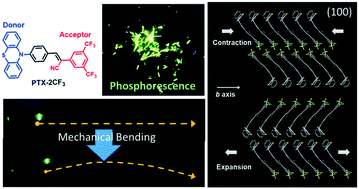
CrystEngComm, 2021,23, 5774-5779
https://doi.org/10.1039/D1CE00475A
Understanding the elastic bending mechanism in a 9,10-anthraquinone crystal through thermal expansion study
Thermal expansion study has been used to understand the mechanism of elastic bending in 9,10-anthraquinone. Expansion along the bending axis due to bending is expected to resemble the thermal expansion along the same direction.
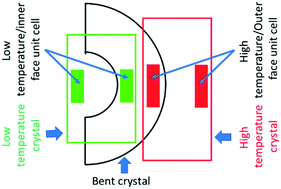
CrystEngComm, 2021,23, 5768-5773
https://doi.org/10.1039/D1CE00467K
Charge-transfer crystal with segregated packing structure constructed with hexaarylbenzene and tetracyanoquinodimethane
Charge-transfer (CT) crystals bearing segregated domains between the hexaarylbenzene and TCNQ are a promising platform for developing new organic functional solid-state materials.
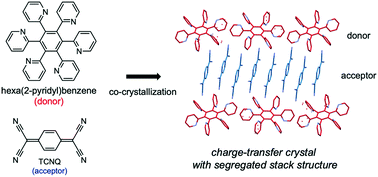
CrystEngComm, 2021,23, 5564-5568
https://doi.org/10.1039/D1CE00726B
Cocrystal hydrate of Bandrowski's base and clotrimazole: a prospective ingredient for hair dye formulations
When crystallized with the antifungal medication clotrimazole, p-phenylenediamine, the most prominent hair developer used in the hair dye industry today, is oxidized to its trimeric product Bandrowski's base, and forms a cocrystal.

CrystEngComm, 2021,23, 5421-5424
https://doi.org/10.1039/D1CE00751C
Solid-state behaviors of imines: colossal biaxial positive thermal expansion, motion capability, and phase transitions
The torsional flexibility of imines affects solid-state packing and properties. Behaviors including colossal thermal expansion, pedal motion, and phase transitions in imine-containing solids are described.
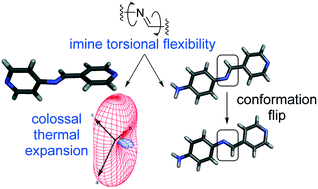
CrystEngComm, 2021,23, 4439-4443
https://doi.org/10.1039/D1CE00706H
Selective formation of form II paracetamol through the assistance of paracetamol co-crystals as templates in a solution
The arrangement of paracetamol templated by the structure of 1 : 1 co-crystal of paracetamol–maleic acid in solution phase facilitating the nucleation of metastable form II paracetamol.
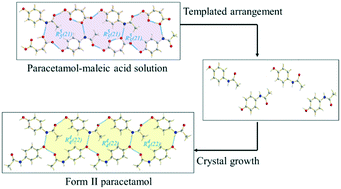
CrystEngComm, 2021,23, 3940-3945
https://doi.org/10.1039/D1CE00034A
Single-crystal to single-crystal transformation of a coordination chain to a two-dimensional coordination network through a photocycloaddition reaction
UV irradiation of a unique ladder-like coordination polymer affords a two-dimensional coordination network through single-crystal to single-crystal photocycloaddition reaction.

CrystEngComm, 2021,23, 2783-2787
https://doi.org/10.1039/D1CE00230A
Detection of hydroxyl and hydride functional groups in a ceria crystal under hydrogen reduction
Neutron powder diffraction analysis revealed that ceria transformed into the oxyhydroxide structure by hydrogen treatment.
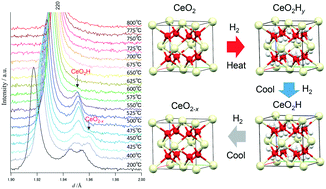
CrystEngComm, 2021,23, 2355-2359
https://doi.org/10.1039/D1CE00130B
A GeSe micro air brick crystal-based film for the sunlight photodegradation of dye-polluted waters
Pinkish purple rhodamine B polluted water was efficiently photodegraded into colorless by the GeSe MAB crystal-based film under sunlight irradiation.

CrystEngComm, 2021,23, 762-768
https://doi.org/10.1039/D0CE01684E
Snowflake porous multi-metal oxide nanocatalysts from metallocene@metal organic framework precursors
Snowflake metallocene@MOF-derived ammonia catalyst.
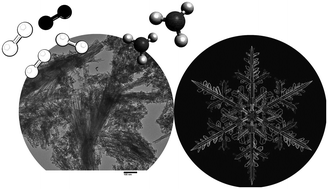
CrystEngComm, 2021,23, 533-537
https://doi.org/10.1039/D0CE01666G
Stabilizing photo-sensitive colchicine through rebalancing electron distribution of the reactive tropolone ring
Photo-sensitive tropolone was stabilized by rebalancing the electron distribution of the reactive system.

CrystEngComm, 2021,23, 30-34
https://doi.org/10.1039/D0CE01551B
Exploring the solid form landscape of the antifungal drug isavuconazole: crystal structure analysis, phase transformation behavior and dissolution performance
Phase transformation of ISV solid forms during dissolution.
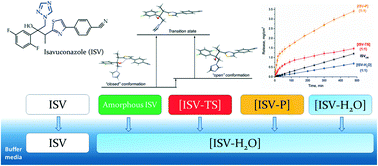
CrystEngComm, 2021,23, 8513-8526
https://doi.org/10.1039/D1CE01353J
Structural insights on Li+ doped P![[6 with combining macron]](https://www.rsc.org/images/entities/char_0036_0304.gif) crystals of upconverting NaYF4:Yb3+/M3+ (M3+ = Er3+ or Tm3+) through extensive synchrotron radiation-based X-ray probing
crystals of upconverting NaYF4:Yb3+/M3+ (M3+ = Er3+ or Tm3+) through extensive synchrotron radiation-based X-ray probing
Intensification of upconversion luminescence (UCL) from a single phase NIR-upconverting (UC) crystal due to perturbation of the local symmetry field may not always manifest through average structural attributes like lattice parameters.
![Graphical abstract: Structural insights on Li+ doped P [[6 with combining macron]] crystals of upconverting NaYF4:Yb3+/M3+ (M3+ = Er3+ or Tm3+) through extensive synchrotron radiation-based X-ray probing](/en/Image/Get?imageInfo.ImageType=GA&imageInfo.ImageIdentifier.ManuscriptID=D1CE01253C&imageInfo.ImageIdentifier.Year=2021)
CrystEngComm, 2021,23, 8631-8640
https://doi.org/10.1039/D1CE01253C
Effect of high purity molybdenum oxide(VI) on crystal growth and OLED technology
The strong influence of MoO3 chemical purity from 99.99 wt% to 99.999 wt% on lithium triborate (LBO) and NaLa(MoO4)2 crystal growth as well as on OLED technologies has been demonstrated.
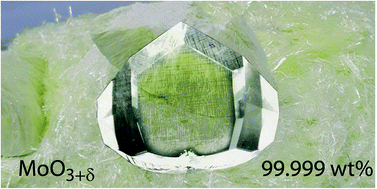
CrystEngComm, 2021,23, 8276-8290
https://doi.org/10.1039/D1CE01322J
Design of solvatomorphic structures based on a polyboronated tetraphenyladamantane molecular tecton
A series of solvatomorphic structures of tetrakis(4-dihydroxyborylphenyl)adamantane were investigated.
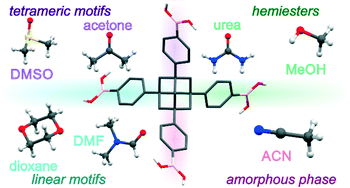
CrystEngComm, 2021,23, 8169-8182
https://doi.org/10.1039/D1CE01297E
Purification of amoxicillin trihydrate in the presence of degradation products by different washing methods
Repeated crystallization or the use of different chemicals to obtain a pure crystal can cause yield/purity issues.
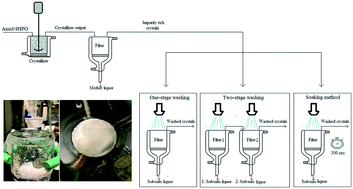
CrystEngComm, 2021,23, 8121-8130
https://doi.org/10.1039/D1CE01073E
Surface-directed ZnGa2O4 and β-Ga2O3 nanofins coated with a non-polar GaN shell based on the Kirkendall effect
Transformation of laterally grown ZnO nanofins by replacing Zn with Ga via the “Kirkendall Effect”.

CrystEngComm, 2021,23, 7955-7962
https://doi.org/10.1039/D1CE00744K
Relationship between crystal shape and unit cell shape: crystal shape modification via co-crystallization toward SXRD-suitable crystals
The relationships between the shape and cell parameters were investigated using 131 crystals of secondary aromatic sulfonamides. And, 11 sulfonamides isolated as oils, amorphous, or needle crystals were co-crystallized to obtain block-like crystals.
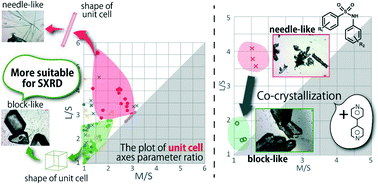
CrystEngComm, 2021,23, 7760-7770
https://doi.org/10.1039/D1CE00897H
Novel solid forms of insomnia drug suvorexant with improved solubility and dissolution: accessing salts from a salt solvate route
Suvorexant (SRX) is a dual orexin receptor antagonist used for the treatment of insomnia.
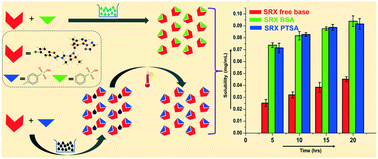
CrystEngComm, 2021,23, 7739-7749
https://doi.org/10.1039/D1CE01269J
Mesoporous Co–Mo–S nanosheet networks as cathode materials for flexible electrochemical capacitors
In this study, we synthesized numerous Co–Mo–S nanosheet networks as electrode materials by a two-step hydrothermal strategy. It delivers a specific capacity of 510 C g−1 at 1 A g−1.
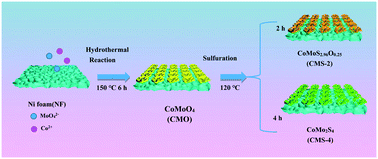
CrystEngComm, 2021,23, 7671-7678
https://doi.org/10.1039/D1CE01186C
High-precision synthesis of α-MnO2 nanowires with controllable crystal facets for propane oxidation
α-MnO2 nanowires with different crystal facets were synthesized. The (110) crystal facet of α-MnO2 is conducive to propane catalysis, due to the lowest electron energy, effectively Mn valence adjustment and abundant oxygen vacancies.
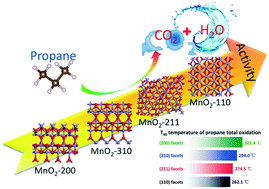
CrystEngComm, 2021,23, 7602-7614
https://doi.org/10.1039/D1CE01044A
Two Cd(II)-based metal–organic frameworks for the highly effective detection of Fe3+ ions and levofloxacin in aqueous media
Two new Cd(II)-MOFs are hydrothermally synthesized and can be applied as dual-response sensors to identify Fe3+ and levofloxacin (LVX) with high selectivity, sensitivity and excellent reusability.
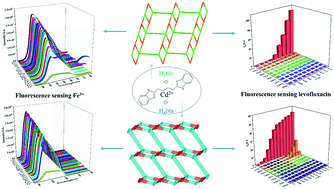
CrystEngComm, 2021,23, 7397-7405
https://doi.org/10.1039/D1CE01128F
Isostructurality of quinoxaline crystal phases: the interplay of weak hydrogen bonds and halogen bonding
Creation of isostructural systems is a balance between thermodynamic and kinetic factors, shown by a set of substituted quinoxalines, where the lighter halogens form a set of metastable isostructural crystals, different to the heavy substitutions.

CrystEngComm, 2021,23, 7108-7117
https://doi.org/10.1039/D1CE00878A
Early stage of the single-crystal growth and tipping point of the cationic site preference in Gd-doped Zintl phase thermoelectric materials
Three novel Zintl phases in the Ca11−xGdxSb10−y system were synthesized, and the early stage of the single-crystal growth process and the “tipping point” of the cationic site preference for the size-factor criterion were thoroughly investigated.
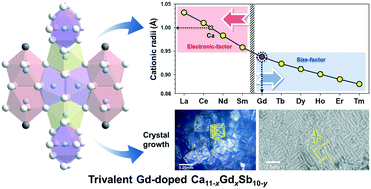
CrystEngComm, 2021,23, 7097-7107
https://doi.org/10.1039/D1CE00877C
Taming the dynamics in a pharmaceutical by cocrystallization: investigating the impact of the coformer by solid-state NMR
The anti-HIV pharmaceutical efavirenz is highly dynamic in its crystalline state, and we show that these dynamics can be tamed through the introduction of a coformer.
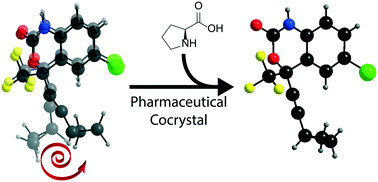
CrystEngComm, 2021,23, 6859-6870
https://doi.org/10.1039/D1CE01084K
Multicomponent crystals of clotrimazole: a combined theoretical and experimental study
Compared with clotrimazole, some multicomponent crystals showed an improvement in solubility and dissolution rate.
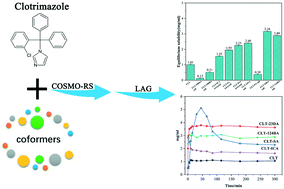
CrystEngComm, 2021,23, 6977-6993
https://doi.org/10.1039/D1CE00934F
Molecular salts of quinine: a crystal engineering route to enhance the aqueous solubility
Salts of quinine, with α,ω-aliphatic dicarboxylic acids, and aromatic coformers, show superior aqueous solubility. The structural, thermal and microscopy data provide structural, compositional, and stability profiles of the salts.
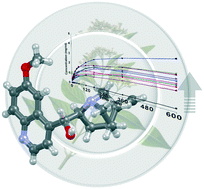
CrystEngComm, 2021,23, 6942-6951
https://doi.org/10.1039/D1CE00791B
Towards new cesium containing manganese vanadates via a precursor method
The first two 3D cesium containing manganese vanadates were synthesized by using K2Mn(VO3)4 as the precursory reactant in concentrated Cs+ aqueous solutions.
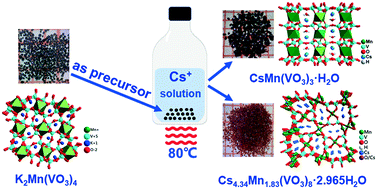
CrystEngComm, 2021,23, 6909-6914
https://doi.org/10.1039/D1CE00921D
High-pressure synthesis and crystal structure of non-centrosymmetric K2Ca3(CO3)4
A new non-centrosymmetric K2Ca3(CO3)4 crystal (P212121, a = 7.39134(18) Å, b = 8.8153(2) Å, c = 16.4803(4) Å) was synthesized in a multi-anvil press at a pressure of 3 GPa and temperature of 975 °C.
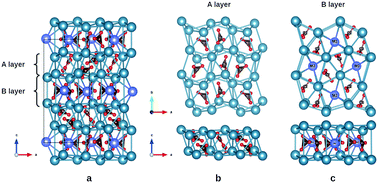
CrystEngComm, 2021,23, 6675-6681
https://doi.org/10.1039/D1CE00882J
The influence of co-doping on the luminescence and thermoluminescence properties of Cu-containing fluoride borate crystals
Copper enters the channels of the Ba12(BO3)6[BO3][LiF4] structure both in the mono- and bivalent states and creates effective luminescence and capture centers. The influence of co-doping with REEs and strontium on properties has been investigated.

CrystEngComm, 2021,23, 6599-6609
https://doi.org/10.1039/D1CE00556A
Series of charge transfer complexes obtained as crystals in a confined environment
A series of charge transfer complexes (CTCs) were successfully formed by solvent free processing techniques, using the 1,2,4,5-tetracyano benzene (TCNB) as πA molecule and a series of p-dihydroquinones (H2Qs) as πD counterparts.
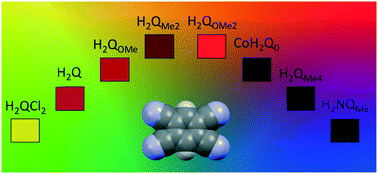
CrystEngComm, 2021,23, 6418-6426
https://doi.org/10.1039/D1CE00929J
A series of novel Co(II)-based MOFs: syntheses, structural diversity, and various properties
Three novel Co(II)-based MOFs, having structural diversities and various properties are successfully synthesized.
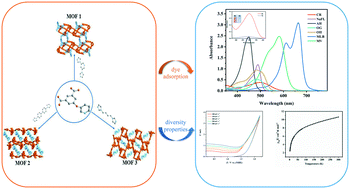
CrystEngComm, 2021,23, 6376-6387
https://doi.org/10.1039/D1CE00783A
Schiff base ligands derived from 1,2-bis(2′-nitro-/amino-phenoxy)-3-R-benzene and 2-hydroxy-1-naphthaldehyde and their Cu/Zn(II) complexes: synthesis, characterization, X-ray structures and computational studies
Racemic crystals of Cu/Zn(II)-tetradentate Schiff base ligands with Λ/Δ-chirality induction at-metal center.

CrystEngComm, 2021,23, 6322-6339
https://doi.org/10.1039/D1CE00829C
Single domain growth and charge ordering of epitaxial YbFe2O4 films
(0001)-Oriented epitaxial YbFe2O4−δ films without twin domains were formed on YSZ (111) substrates. The charge ordered structure and the large magnetization comparable to bulk single crystals were confirmed on the films.
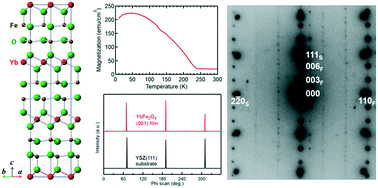
CrystEngComm, 2021,23, 6163-6170
https://doi.org/10.1039/D1CE00834J
New insight into improving the solubility of poorly soluble drugs by preventing the formation of their hydrogen-bonds: a case of dapsone salts with camphorsulfonic and 5-sulfosalicylic acid
The improved solubility of two salts of dapsone (DAP) was investigated from the view point of structures and hydrogen bonding.
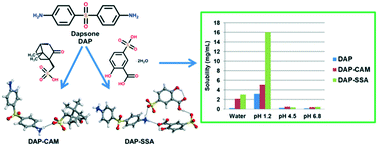
CrystEngComm, 2021,23, 6191-6198
https://doi.org/10.1039/D1CE00847A
Salts, solvates and hydrates of the multi-kinase inhibitor drug pazopanib with hydroxybenzoic acids
Eight cocrystal-salts of the multi-kinase drug pazopanib with hydroxybenzoic acids are sustained by the strong, ionic aminopyridinium⋯carboxylate heterosynthon of N–H⋯O hydrogen bonds between the carboxylic acid donor and amino-pyrimidine acceptor.
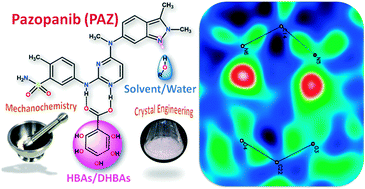
CrystEngComm, 2021,23, 5994-6011
https://doi.org/10.1039/D1CE00785H
A new monohydrated molecular salt of GABA with L-tartaric acid: the structure-forming role of water
A novel monohydrated molecular salt of GABA with L-tartaric acid was crystallized and investigated.
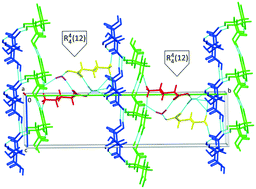
CrystEngComm, 2021,23, 6086-6092
https://doi.org/10.1039/D1CE00470K
Tuning the mechanical flexibility of organic molecular crystals by polymorphism for flexible optical waveguides
The ability to selectively tune the optical and the mechanical properties of organic molecular crystals offers a promising approach towards developing flexible optical devices.
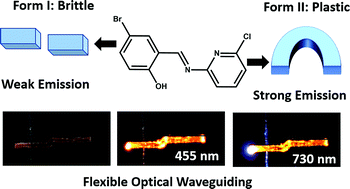
CrystEngComm, 2021,23, 5815-5825
https://doi.org/10.1039/D1CE00642H
Effect of dehydration pathway on the surface properties of molecular crystals
Atomic force microscopy was used to determine roughness, elastic modulus and work function after thermally-induced and solvent-induced dehydration. These properties correlated with electric charging to provide insight into behaviour of bulk powders.
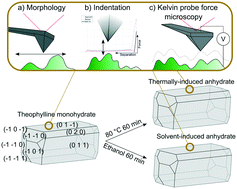
CrystEngComm, 2021,23, 5788-5794
https://doi.org/10.1039/D1CE00539A
Photoinduced topographical surface changes and photoresponse of the crystals of 7-methoxycoumarin
Photoinduced topographical changes, bending, and photosalient effect due to the dimerization reaction were observed on a single crystal of 7-methoxycoumarin, upon deep UV (254 nm) light irradiation.
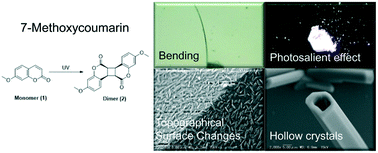
CrystEngComm, 2021,23, 5780-5787
https://doi.org/10.1039/D1CE00444A
Light-fueled rapid macroscopic motion of a green fluorescent organic crystal
We report here a new green fluorescent organic crystal of an amide functionalized acrylonitrile derivative (E-ArF2) that displays various types of macroscopic response when illuminated with UV light (390 nm).
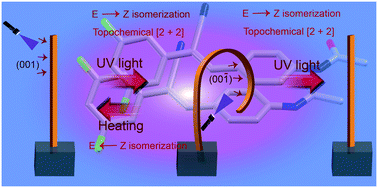
CrystEngComm, 2021,23, 5876-5881
https://doi.org/10.1039/D1CE00460C
Fluorine as a robust balancer for tuning the reactivity of topo-photoreactions of chalcones and the photomechanical effects of molecular crystals
The higher the number of fluorine atoms, the higher the topological photo-induced [2 + 2] cycloaddition reactivity of chalcones.
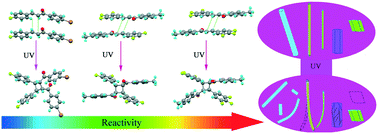
CrystEngComm, 2021,23, 5856-5868
https://doi.org/10.1039/D1CE00086A
Actuation performance of a photo-bending crystal modeled by machine learning-based regression
The bending deflection and blocking force of photo-bending crystals of different sizes were experimentally measured at various light intensities, and then modeled by the machine learning-based regression.
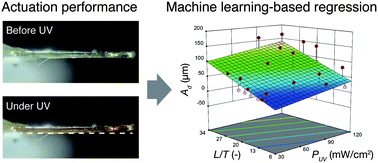
CrystEngComm, 2021,23, 5839-5847
https://doi.org/10.1039/D1CE00208B
Epimers with distinct mechanical behaviours
Two epimeric series of esters exhibit distinct mechanical behaviour: brittle crystals for one series and ductile crystals for the other series.
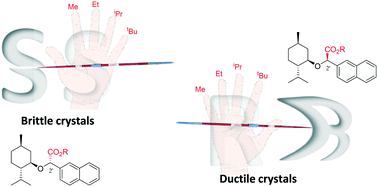
CrystEngComm, 2021,23, 5848-5855
https://doi.org/10.1039/D0CE01723J
Probing anisotropic mechanical behaviour in carbamazepine form III
Nanoindentation measurements in single crystals of carbamazepine form III show that the (020) face is stiffer and harder than the (002) and (101) faces. AFM imaging and molecular simulations reveal that the (020) plane is the most likely slip plane.
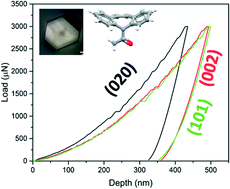
CrystEngComm, 2021,23, 5826-5838
https://doi.org/10.1039/D0CE01659D
Multi-site Cr3+ occupation-related broadband NIR luminescence in Cr3+-doped Li3Mg2NbO6
Broadband NIR luminescence from the Li3Mg2NbO6:Cr3+ phosphor is related to the multi-site occupation behavior of Cr3+.
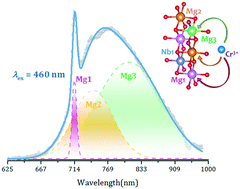
CrystEngComm, 2021,23, 5585-5594
https://doi.org/10.1039/D1CE00746G
Enhanced up-conversion emission in Er3+-doped barium–natrium–yttrium–fluoride phosphors by alkali ion introduction under 1550 nm excitation
This figure shows the emission spectra of nanocrystals with different Li+ ion introducing concentrations at 1550 nm. Compared with the untreated samples, when the Li+ ion introducing concentration is 0.2 mol%, the luminescence intensity of the sample is improved obviously.
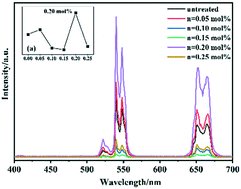
CrystEngComm, 2021,23, 5601-5608
https://doi.org/10.1039/D1CE00695A
Cocrystallization of axitinib with carboxylic acids: preparation, crystal structures and dissolution behavior
Three cocrystals of axitinib were prepared, and they demonstrated a significantly improved apparent solubility and dissolution rate without compromising physical stability.
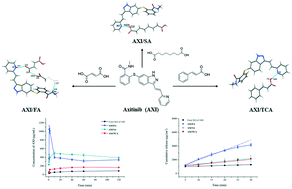
CrystEngComm, 2021,23, 5504-5515
https://doi.org/10.1039/D1CE00620G
Efficient capturing of hydrogen peroxide in dilute aqueous solution by co-crystallization with amino acids
X-ray structure analyses of co-crystals of H2O2 and L-Phe, DL-Phe, or DL-Asp prepared in a dilute aqueous solution (30 wt%) indicated that multi-layer motifs including water molecule is important for highly efficient H2O2 capture in dilute solutions.
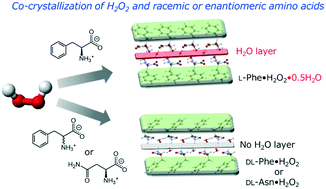
CrystEngComm, 2021,23, 5456-5462
https://doi.org/10.1039/D1CE00688F
Cation disorder and bond anharmonicity synergistically boosts the thermoelectric performance of p-type AgSbSe2
Atomic bonding with simple 1D spring and ball model for the phonon–phonon interaction, which arises from 5s2 lone pair electrons.
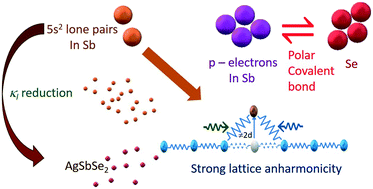
CrystEngComm, 2021,23, 5522-5530
https://doi.org/10.1039/D1CE00599E
Imino-bridged N-rich energetic materials: C4H3N17 and their derivatives assembled from the powerful combination of four tetrazoles
Imino-bridged symmetric N-rich energetic materials with high energetics and good stability.
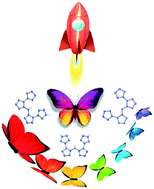
CrystEngComm, 2021,23, 5377-5384
https://doi.org/10.1039/D1CE00674F
Nucleation kinetics for primary, secondary and ultrasound-induced paracetamol crystallization
Investigation into the effect of different nucleation mechanisms on the nucleation rate for paracetamol crystallization in stirred microvials.
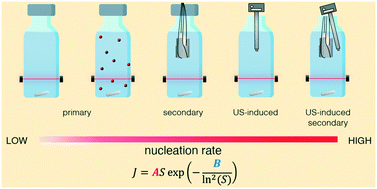
CrystEngComm, 2021,23, 5164-5175
https://doi.org/10.1039/D1CE00676B
Proton conductivities of four low dimensional MOFs: affected by the amount of chelated ligands
The smaller the proportion of the chelated ligand, the more water molecules in the compound, which increases the chance of forming continuous hydrogen bonds, enhances the water absorption ability, and improves the proton conductivity of the compound.
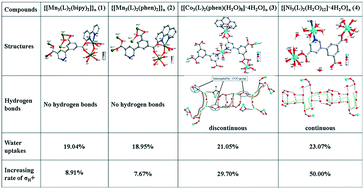
CrystEngComm, 2021,23, 5106-5115
https://doi.org/10.1039/D1CE00589H
Unprecedented copper(II) coordination induced nucleophilic cleavage of a quinoxaline heterocycle: structural and computational studies
This research work deals with the unprecedented copper(II) induced nucleophilic cleavage of a quinoxaline heterocycle with spectroscopic, structural and computational studies.
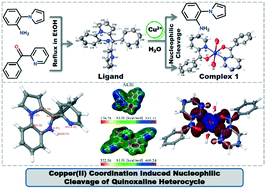
CrystEngComm, 2021,23, 5078-5086
https://doi.org/10.1039/D1CE00569C
Photomechanical response of sulfonylhydrazone molecular crystals
Photomechanical responses of the single crystals of a series of sulfonylhydrazones are explored for the first time.
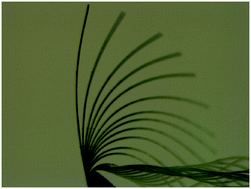
CrystEngComm, 2021,23, 4910-4916
https://doi.org/10.1039/D1CE00478F
Managing hydrogen bonding in the clathrate hydrate of the 1-pentanol guest molecule
1-pentanol, long-chain alcohol molecule, can be encaged in the clathrate hydrate by managing the destabilizing influence of guest–host hydrogen bonding.
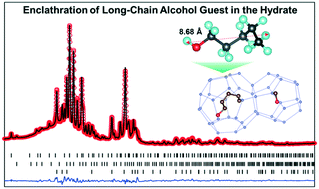
CrystEngComm, 2021,23, 4708-4716
https://doi.org/10.1039/D1CE00583A
Evaluating the high-pressure structural response and crystal lattice interactions of the magnetically-bistable organic radical TTTA
Paramagnetic suppression in TTTA at pressure is caused by a steady decrease in the separation between moieties containing the radical electron along π-stacking chains with no phase transition.
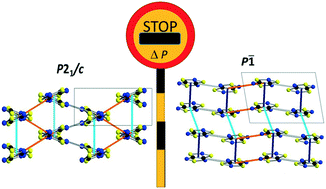
CrystEngComm, 2021,23, 4444-4450
https://doi.org/10.1039/D1CE00577D
About this collection
The latest research on Crystal Engineering Techniques published in CrystEngComm.